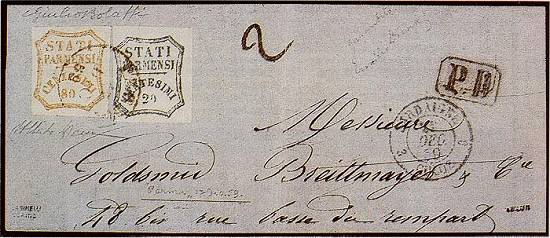The
issue - general introduction
As written
in the historic introduction, the Parma Duchy too was united with the Sardinia
Kingdom, in the ways I have already briefly described. Also the postage stamps
were to be changed to eliminate any marks of the past dominion.
As usual from Turin the delivery of the new stamps of the IV Sardinia issue
arrived. They have been put in circulation August 1st 1859 (but they were already
in Parma from June end!). Nevertheless the thing was not fully correct from
the administrative point of view because the official annexation to the Sardinia
Kingdom was supposed to arrive only with the plebiscite of 12th-14th August
and with the Popular Assembly of September 1859.
A new set of stamps was decided, despite the Sardinian ones were allowed to
circulate (creating very rare postage combinations). The creative effort was
not so huge, because the stereotypes used to make the newspaper revenues stamps
were used (see introduction to the newspaper issues). A precise date
of issue does not exist, while the oldest date of use found is August 27th 1859.
The minting die for the newspaper revenue stamps was made once again by Donnino
Bentelli. From this the number "9" was eliminated and substituted
with typographic characters to create the new values. The subject is an octagon
made by curved lines where is placed the label "STATI PARMENSI" with
under it an horizontal dividing line; in the lower part of the stamp there is
the semicircular label "CENTESIMI" and under it the indication of
the value. The printing is typographic, in color, on white machine made paper,
without watermark, of low quality.
The job of introducing the values did not give bright results; numbers upside
down, incomplete, misalignments and various label damages are common. Slightly
different also was the spacing between the samples in comparison with the newspaper
values because typographic inter-spaces have been inserted in the composition
(some of them left small traces on the stamp sides). In the composition of the
values two different types of "0" have been also used, one large and
one narrow.
Sheets of 60 pieces were printed (10 rows of 6), in two different printing runs,
moving the position of some stereotypes in the sheet. Here the succession of
the different printing runs and the oldest known dates of use:
|
5 centesimi
|
Green-blue
- 1st printing
|
September
9th, 1859
|
|
5 centesimi
|
Green
yellow - 2nd printing
|
November
3rd, 1859
|
|
10 centesimi
|
Brown
- 1st printing
|
August
27th, 1859
|
|
10 centesimi
|
Brown
- 2nd printing
|
-
|
|
20 centesimi
|
Blue
- 1st printing
|
August
31st, 1859
|
|
20 centesimi
|
Blue
- 2nd printing
|
-
|
|
40 centesimi
|
Red
brown - 1st printing
|
September
5th 1859
|
|
40 centesimi
|
Vermilion
- 2nd printing
|
November
25th, 1859
|
|
80 centesimi
|
Bistre
orange
|
November
27th, 1859
|
As it
can be noticed, all the values were reprinted with the exception of the 80 centesimi;
for the 5 and the 40 centesimi the color somehow different is key to recognize
the printing run; very difficult instead is for the values of 10 and 20 centesimi,
to the point that they are not even catalogued in distinct way (the criteria,
when possible, is the date of the cancellation, on the shape of the "0"
and on small chromatic variations). Between the varieties we find stereotypes
defects (that, let's not forget, were already on the newspaper stamps), damages
or badly printed, bumped frames and some offsets.
The quantities printed are known and, in summary, are the following:
|
5 centesimi
|
1st
printing
|
18.000
|
|
5 centesimi
|
2nd
printing
|
19.200
|
|
10 centesimi
|
1st
printing
|
18.000
|
|
10 centesimi
|
2nd
printing
|
31.200
|
|
20 centesimi
|
1st
printing
|
60.000
|
|
20 centesimi
|
2nd
printing
|
31.200
|
|
40 centesimi
|
1st
printing
|
3.600
|
|
40 centesimi
|
2nd
printing
|
12.000
|
|
80 centesimi
|
Unique
printing
|
2.400
|
The remainders were later on placed on the philatelic market.
I want to emphasize as of the 80 centesimi only 68 pieces were sold; to today
only one sample on envelope and 5 used pieces are known. It is considered
the biggest rarity of the Old Italian States and one of the rarest in the
world (Fig. 1).
They were valid up to January 31st 1860 but the use was tolerated in February
too.

Fig. 1:
the only known envelope with the 80 centesimi: the biggest rarity of the Old
Italian States
(from "Catalogo Sassone Specializzato", ed. 2001)
